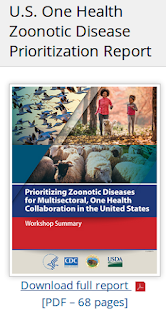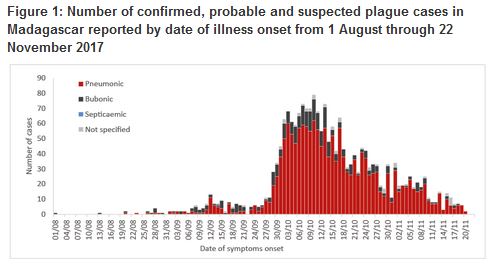#14,145
Six weeks ago, in CDC: The 8 Zoonotic Diseases Of Most Concern In The United States, we looked at a joint CDC, USDA, DOI report on the top (n=56) zoonotic diseases of national concern for the United States (see chart below).
Zoonotic disease are those carried by non-human species, but which can spill over into human beings. Of these 56 diseases examined, 8 were selected as being of particular concern in the United States.
The zoonotic diseases of most concern in the U.S. are:Zoonotic influenzas (avian, swine, canine, etc.) have been the primary focus of this blog since its inception, but over the years we've looked at all of these disease threats at one time or another.
- Zoonotic influenza
- Salmonellosis
- West Nile virus
- Plague
- Emerging coronaviruses (e.g., severe acute respiratory syndrome and Middle East respiratory syndrome)
- Rabies
- Brucellosis
- Lyme disease
One that comes up fairly often, and sits at #4 on the U.S. threats list, is Plague.The US reports an average of seven human plague cases each year (range: 1–17 cases per year) - mostly bubonic - and almost always in the Western states.
 |
| CREDIT CDC |
Globally, a couple of thousand plague cases are reported each year, mostly in rural areas of Africa, Asia, and South America, with Madagascar the hardest, and most consistently hit region.
Bubonic Plague (Yersinia Pestis) - carried by rats and
transmitted by fleas - sets up in the lymphatic system, resulting in the
tell-tale buboes, or swollen lymph glands in the the groin, armpits,
and neck.
Bubonic plague is the most common - and most treatable - presentation, however in rare cases, Pneumonic Plague may develop.
 |
| Credit CDC |
Here the infected person develops a severe pneumonia, with coughing and hemoptysis (expectoration of blood), and may spread the disease by droplets from human-to-human.
While most plague outbreaks have been small, primarily bubonic, and mostly involved sporadic cases in rural areas - in the fall of 2017 we saw a large pneumonic plague outbreak that spread through urban areas Madagascar.
While this outbreak - the worst since India's 1994 outbreak (summarized here) - was eventually contained, this came just 3 years after West Africa's Ebola epidemic demonstrated its ability to spread in an urban environment.
While this outbreak - the worst since India's 1994 outbreak (summarized here) - was eventually contained, this came just 3 years after West Africa's Ebola epidemic demonstrated its ability to spread in an urban environment.
I've only included excerpts from a much longer review, so follow the link to read it in its entirety. I'll have a brief postscript when you return.All of which brings us to the latest WHO WER (Epidemiological Weekly Record) which reviews the 2017 Madagascar outbreak, examines plague's global status in 2019, and discusses some of the risks going forward.
Plague around the world in 2019
Eric Bertherat
On 13 September 2017 the Ministry of Health of the Republic of Madagascar notified WHO under the International Health Regulations 2005 (IHR) of an epidemic of pulmonary plague which appeared exceptional due to its extent and its urban character. The episode had been detected 2 days earlier following the death of a 47-year-old woman admitted to hospital in respiratory distress in the capital Antananarivo.
The investigation revealed that the index case was a 31-year-old man who died on 27 August while riding in a public taxi, but not before infecting a number of other travellers. All these contacts died within 48 hours, transmitting the infection to others after travelling to different parts of the country.
Between 1 August and 27 November 2017,when the Ministry of Health reported the urban epidemic under control, a total of 597 confirmed or probable cases were reported. Of these, 418 were the pulmonary form and 84% of them occurred in the capital or in the main port city of the country, Toamasina.
Although the mobilization of the Malagasy authorities and the massive support of international partners made it possible to limit the total number of victims to 55, the epidemic caused a degree of panic in the population. This epidemic also disrupted a health system that was already struggling to meet the needs of the population.
The confirmation of human-to-human transmission in urban areas, near ports and international airports, naturally caused much concern abroad, especially in States and territories of the Indian Ocean. This had a considerable indirect economic impact for one of the world’s poorest countries.
An epidemic of pulmonary plague in urban areas in Madagascar was a much feared and expected disaster. The epidemic of August 2017 can be considered the mostsevere reported in the world for a quarter of a century (876 cases including 54 deaths in India in 1994).
(SNIP)
Conclusion
The global incidence of human plague is the lowest reported in 30 years, and the actual incidence is probably little different. It is hard to say why.
This forgotten disease usually receives very little attention from the international community and donors, and is not the subject of intensive control programmed in endemic countries. The development of – and an increase in – the standard of living might explain this in countries where plague is a disease of poverty, but the countries most affected such as Madagascar and DRC have been experiencing considerable social and economic difficulties for several years now.
In the absence of animal surveillance data in most cases, it is not possible to take the analysis any further. Like many infectious diseases, plague has large multiannual cycles, the cause of which is not always apparent.However, we must remain extremely vigilant.
It is not uncommon to observe epidemiological silences of several decades in natural plague foci, and the sudden appearance of human cases is always destabilizing for national or even international authorities. Thus, on 1 May 2019, 2 people died of septicemia in Mongolia in the province of Bayan-Logia, on the border with China and Russia. On the other hand, natural foci tend to expand, significantly increasing the human population at risk.
Finally, as shown by the event that occurred in Madagascar in late 2017, plague remains a particularly formidable epidemic disease, especially when its pulmonary form manifests itself in an urban setting.
Affiliations of authorsa Health Emergencies Programme (WHE), World Health Organization, Geneva, Switzerland (corresponding author: Éric Bertherat, bertherate@who.int).
I confess to having a strong interest in Plague, which stems from my reading – as a youth – James Leasor’s The Plague and The Fire which recounts two incredible years in London’s history (1665-1666) - which began with the Great plague, and ended with the Fire of London.
A highly recommended read (if you can find a copy) for both history and epidemic aficionados.




